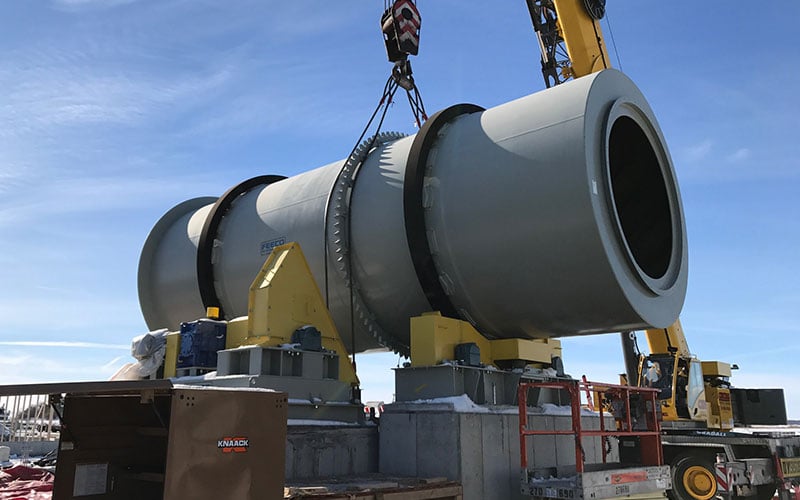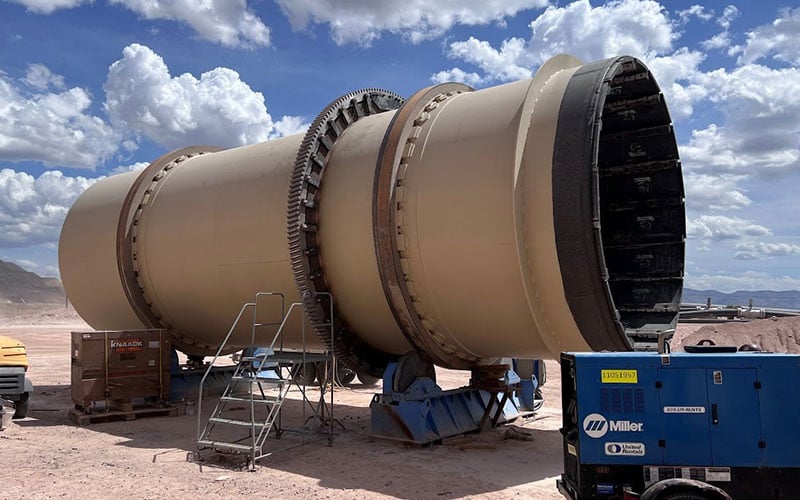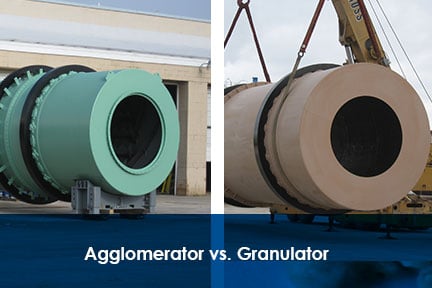When looking for versatile manufacturing equipment capable of producing granules, rotary drums are often the equipment of choice. However, confusion frequently arises in choosing between an agglomerator and granulator.
Because rotary drums are flexible in design and capable of processing large capacities, they are extensively used in many different industries. Unfortunately, the pervasive use of these drums has created a multitude of naming opportunities and, along with it, the potential for confusion. Agglomeration drums, rotary granulators, and balling drums are just a few of the names used to label rotary drum equipment applied in granulation settings.
Typical rotary Drum Characteristics
Due to their robust design and ability to handle material fluctuation, drums are considered a work horse in many industries. They enhance product characteristics, improve material handling qualities, and reduce waste associated with dust issues. Most drums utilize:
- A tumbling, cascading motion on the intended granule
- An inclined drum capable of handling a large capacity
- Pre-moistened feed material or liquid spray within the drum
- The ability to run large recycles of undersized and oversized granules
- The (potential) use of flights, or if necessary, scrapers, to move material through the drum.
Additionally, drums are the preferred equipment choice when an application combines a chemical reaction process with agglomeration.
Drum Applications and Categories
Rotary drum equipment is used in a number of industries, with the most common applications being in mining and fertilizer production. Drums used for fertilizer purposes are usually considered granulation drums, while drums used for mineral processing are usually considered agglomeration drums. Other industries also use these drums to process material into pellets or apply a coating to a material and may have their own name for the equipment.
GranulatOrs
The term “granulator” is most often used in fertilizer production or other agricultural applications. The tumbling motion inside a granulation drum creates blended, uniform fertilizer granules that are easy to handle and apply. Granulation drums often include a lining as a protective measure against corrosive materials.
Common names for a granulation drum include:
- Granulator
- Granulation Drum (Drum Granulator, Granulator Drum, etc.)
- Rotary Granulator
- Rotary Drum Granulator
- Rotary Drum Fertilizer Granulator

Fertilizer Granulator
Agglomerators
The term “agglomerator” is typically used in mining applications. While they utilize the same tumbling action as employed in a “granulator,” there can be one notable difference between granulators and agglomerators.
Agglomerators are often designed to handle higher capacities. As such, the size of an agglomeration drum tends to range from medium to large in order to handle the high throughputs associated with ore mining and processing. As with a granulator, agglomerator applications also often include a lining as a protective measure against abrasive material and/or corrosive materials.
While most of the naming confusion for agglomeration drums is contextual, some of it stems from unique processes undertaken by customized drum equipment. Balling drums, for instance, are designed to agglomerate iron ore into rolled balls (pellets). Additionally, heap leaching drums extract usable metal from ore.
Common names for an agglomeration drum include:
- Agglomerator
- Agglomerator Drum (Drum Agglomerator, Agglomeration Drum, etc.)
- Drum Pelletizer
- Rotary Agglomerator
- Rotary Drum Agglomerator
- Heap Leaching Drum
- Ore Drum
- Balling Drum

Mining Agglomerator
Specialty Drums
More specialized rotary drum applications merit their own category, as they process material in capacities outside typical mining and agricultural processes. In addition to forming material into granules or pellets, specialty drums are also used to coat material and/or mix material with various components.
These rotary drums may have specialized internals such as tumbling flights or elaborate spray systems in order to carry out their objective.
Common specialty drums include:

Coating Drum
FEECO creates reliable, highly engineered granulation and agglomeration drum equipment customized to solve the material needs of numerous industries worldwide. Backed by a state-of-the-art testing facility and an extensive process background, FEECO is able to deliver the latest in rotary drum technology. We also offer an extensive parts and service program to keep rotary drums running reliably. For more information, contact us today!


